Tracking Dinosaur Stomping Grounds
Jurassic footsteps lie among the wonders outside Moab, Utah
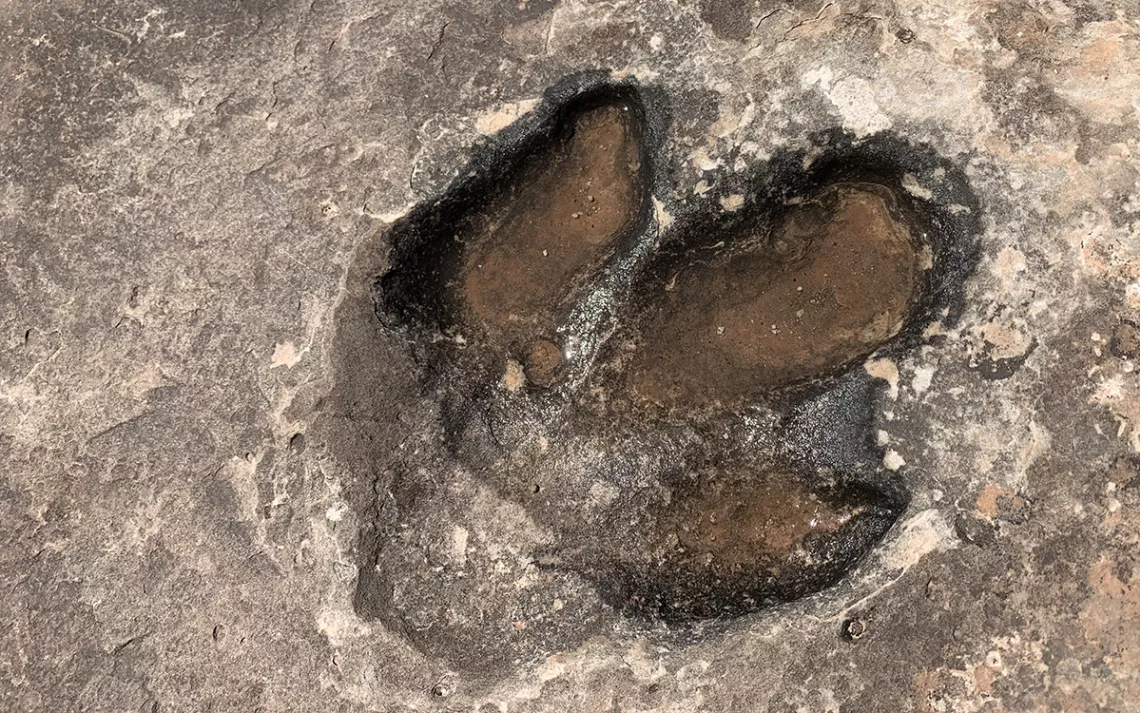
Photos courtesy of Riley Black
“Mega steps!” It was the third time I’d shouted the phrase that morning as I slowly navigated my Subaru along the dusty rut of a road toward the trailhead. Every time, my girlfriend, Splash, smiled and laughed. We were off to visit with dinosaurs, after all. Who wouldn’t be excited?
I’d heard about the sun-baked spot years before, but I didn’t quite know how to find it. Outside of Moab, Utah, among the shifted and cracked Mesozoic hills, lies a place where erosion has naturally exposed thousands of dinosaur tracks. It’s just the sort of thing I’d come west to see. Ever since I moved to Utah in 2011, I’ve been returning to the almost fantastically grandiose geology of the Moab area, often on fossil expeditions with the Natural History Museum of Utah. On paleontological pursuits, I’ve dug at the historic Dystrophaeus quarry, found ancient reptile tracks in Canyonlands, and of course stopped by Poison Spider, Copper Ridge, and Mill Canyon to see public displays of fossils. But the Stomping Grounds are something else altogether—the track site offered the opportunity to see something new and unlike anything else I’d looked for.
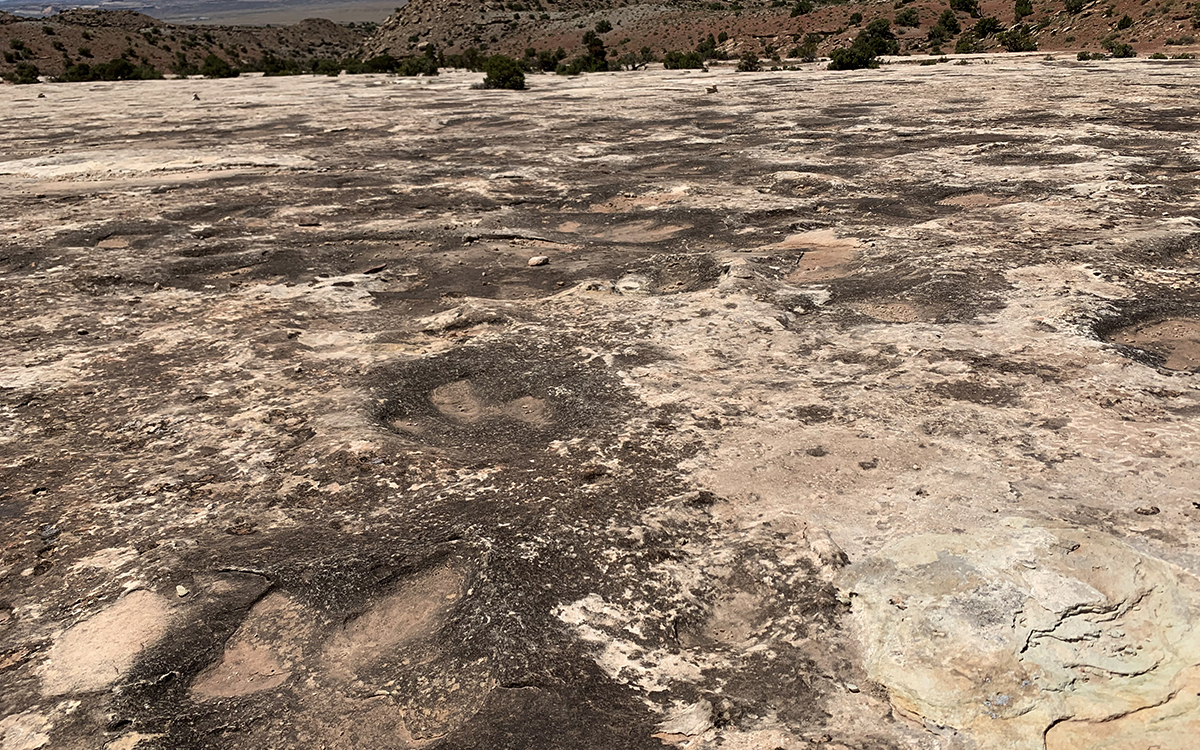 Still, I wasn’t entirely sure how to find the place. On a sunny May morning, Splash, my German shepherd Jet, and I piled into my car and headed out to Copper Ridge. This famous track site was preserved millions of years after the formation of the Stomping Grounds, I knew, and includes the limping steps of a large predator dinosaur that was somehow hobbled. While Jet drank freshly collected rainwater from the tracks and Splash examined the three-toed footprints, I hopped on my phone to see if I might find directions to the Stomping Grounds. Moab has taken so much pride in its fossil history that point-by-point directions now exist online. As luck would have it, the trailhead was just down the dirt road—all we had to do was roll down to the Mega Steps mountain bike trailhead. So with another “Mega steps!” rallying cry, we scuffed our way over the slickrock back to the car and started to the next spot.
Still, I wasn’t entirely sure how to find the place. On a sunny May morning, Splash, my German shepherd Jet, and I piled into my car and headed out to Copper Ridge. This famous track site was preserved millions of years after the formation of the Stomping Grounds, I knew, and includes the limping steps of a large predator dinosaur that was somehow hobbled. While Jet drank freshly collected rainwater from the tracks and Splash examined the three-toed footprints, I hopped on my phone to see if I might find directions to the Stomping Grounds. Moab has taken so much pride in its fossil history that point-by-point directions now exist online. As luck would have it, the trailhead was just down the dirt road—all we had to do was roll down to the Mega Steps mountain bike trailhead. So with another “Mega steps!” rallying cry, we scuffed our way over the slickrock back to the car and started to the next spot.
I needed this. I needed something to reinvigorate my sense of adventure. A memory that wouldn’t cut or dredge up emotional twinges from the depths of my now-extinct marriage. Six months apart hadn’t done much to overwrite the past, especially when we had spent almost 13 years camping together, exploring the Beehive State. In fact, my partner had convinced me to move out here during a 2009 trip that I thought was a vacation but was really more of a sales pitch. We only got two days into our initial foray when I knew I had to be in Utah. And soon after our arrival, during Memorial Day weekend of 2011, I saw Moab and its famous arches for the first time. I knew this was the place I’d been missing all my life.
Those foundational memories still formed the emotional bedrock of my connection to this cactus-studded desert. I knew I’d never get rid of them, but maybe they could become overlain by new strata. I had already started to do that with Splash—a whole new emotional formation had started to accrete as we flew back and forth between Raleigh and Salt Lake City, growing something new. But I wanted to do something as unique for me as for her, to forge a pocket in time that could be ours. So, we’d follow dinosaurs together.
The drive only took a few minutes. From the trailhead sign, which directed us to start on the Mega Steps trail before crossing the Dino Flow and continuing back into the reaches of the Jurassic, the path took a straight line into pillowy stacks of Mesozoic stone. It was immediately apparent just how unseasonably wet the spring of 2019 had been. Invasive cheatgrass wafted in royal purple hues instead of the crisp, dry yellow I so often associate with the fire-prone plant, and the exposed soil of the path was still a little damp from previous nights’ rains. Splash and I filled up our water bottles and, with Jet leading the way as if he knew precisely where we were going, we embarked by foot on our time travel.
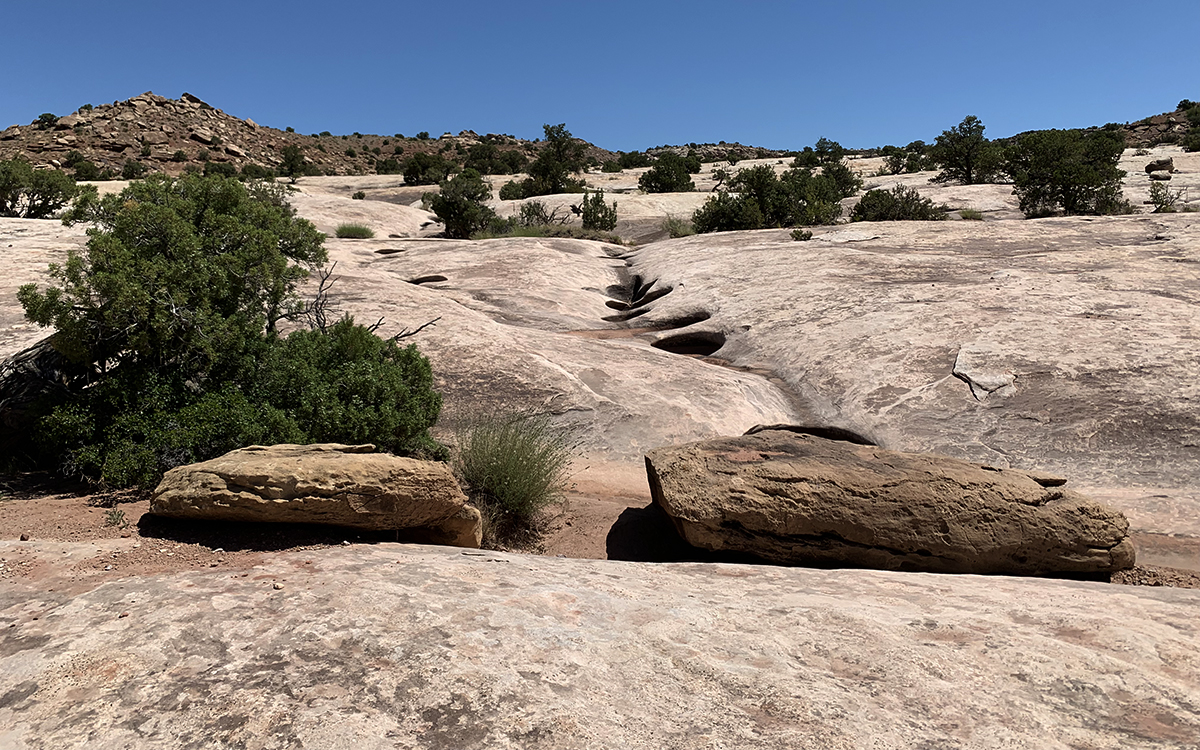
I was already about a third of the way through my water bottle by the time we crossed the flat and picked up the yellow dashes weaving through the pale rock. The sun can be relentless. Thoughts like “Maybe I don’t need sunscreen; it’s only three miles round-trip” and “Ah, I’ll leave water in the car” are unwise here. Even the little tree lizards, common desert companions in this area, must have retired to the shade by the time we started. Still, the fortuitous spillover from the spring rains was apparent everywhere. Here and there, hedgehog, prickly pear, and fishhook cacti put out extravagant blooms, much to the joy of local pollinators. In an ephemeral stream that was running with cool water, Jet splashed and wagged to his heart’s content.
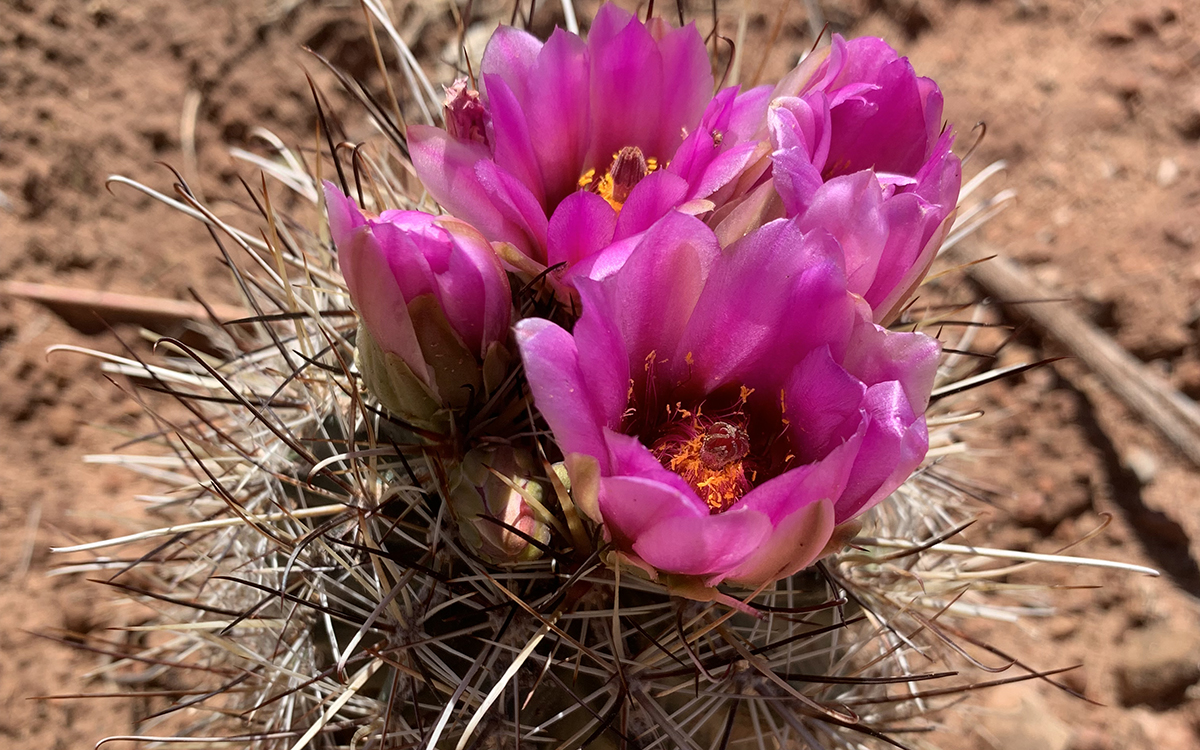 For every water-filled pocket of rock we encountered, we detoured so Jet could refill his tank and have another romp. More than once, Splash and I stopped, squinted, and tried to regain our bearings. Somewhere along the first mile, the yellow dashes gave way to cairns. Some were so low that we were unsure whether they were markers or just rocks that had toppled. A combination of dashes and rock stacks ushered us into the last half mile, at which point we stepped onto gray Entrada Sandstone. Over our shoulders, the highway and the towering front gates of Dead Horse Point and Island in the Sky rose up from the basin. As we ventured into the depths of time, we’d climbed a bit.
For every water-filled pocket of rock we encountered, we detoured so Jet could refill his tank and have another romp. More than once, Splash and I stopped, squinted, and tried to regain our bearings. Somewhere along the first mile, the yellow dashes gave way to cairns. Some were so low that we were unsure whether they were markers or just rocks that had toppled. A combination of dashes and rock stacks ushered us into the last half mile, at which point we stepped onto gray Entrada Sandstone. Over our shoulders, the highway and the towering front gates of Dead Horse Point and Island in the Sky rose up from the basin. As we ventured into the depths of time, we’d climbed a bit.
I looked around, starting to doubt the trailhead’s signage, promising that the walk out was only a mile and a half. But then I spotted tracks. There were dozens, hundreds, of water-filled indentations before a little interpretive signpost. The Stomping Grounds.
Splash, Jet, and I did our own bit of stomping as we explored this dinosaur dance floor. Soon we found isolated footprints, trackways marking the steps of individual dinosaurs as they ambled along an ancient shoreline, and tracks pressed atop others into prehistoric squish. All had been left by medium-size carnivorous dinosaurs—standing about five feet tall at the hips—that congregated along what had been a beach flat back when the Jurassic Sundance Sea covered much of what’s now Utah. There are other Entrada tracks in the area. Drive high up into the La Sal Mountains, the range that makes Moab’s picturesque backdrop, and you’ll see a few more at a US Forest Service pullout. These tracks were created at roughly the same time as those at the Stomping Grounds but were thrust up high into the air as the La Sal Mountains rose up from beneath the overlying stone. But no track site in the area can match the Stomping Grounds in terms of volume; i.e., just how many dinosaurs trod over one place.
No one knows why the dinosaurs found the Stomping Grounds such a good spot to smoosh their three-toed feet into the sand. Perhaps this was a natural pinch point in the local landscape, a spit of shore that connected hunting grounds. Or perhaps it was a buffet. Maybe ancient storms washed marine morsels onto shore. We may never know. But each and every footfall represents a moment of Jurassic time. Splash and I followed them, sometimes crouching with a bit of a snarl to truly get into the spirit of things, rising onto the balls of our feet and turning our hands into three-fingered facsimiles of what these dinosaurs had.
We didn’t see a single other person on the trail that day. Moab’s main street was bustling with holiday traffic, and the undeveloped campsites out by Willow Springs were a cacophony of motorbike sound pollution reverberating off the giant RVs parked shoulder to shoulder. Still, no one else had ventured out into these hills. For a little while, we had the whole of the Jurassic beach to ourselves. I wasn’t pained by the past here. Instead, something new fossilized in my memory—a morning of sun, sand, and dinosaurs.
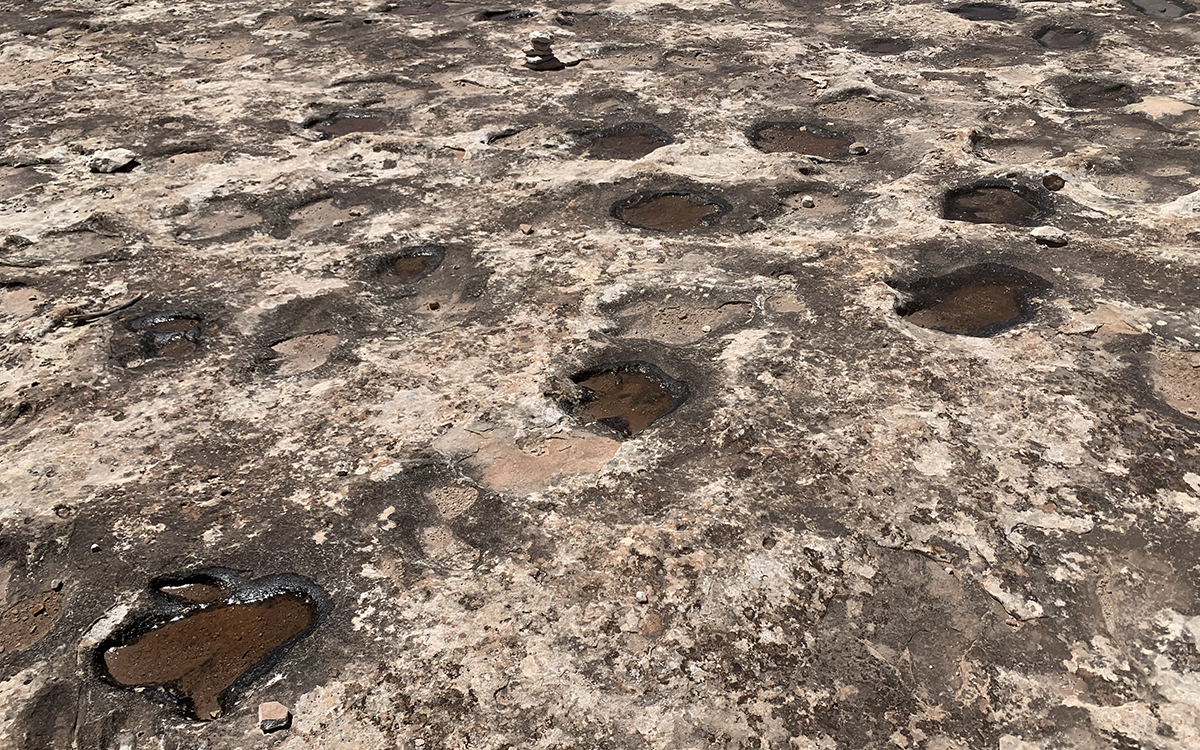
Follow in the Writer's Footsteps
Where: The Stomping Grounds, Moab, Utah
Getting there: The trailhead for the Stomping Grounds trail is easy to find with a smartphone map app. From Moab, head north out of town on US-191 for 22.9 miles. You’ll turn right onto BLM 142/Copper Ridge Jeep Safari road, cross railroad tracks, and drive the dirt road for about a mile before bearing right. After another half mile you’ll bear left and will arrive at the trailhead in less than a half mile. Signs pointing to dinosaur tracks will help, but pay attention because there is another famous set—the Copper Ridge Dinosaur Tracks—in the area, so keep your eyes peeled for the Mega Steps trailhead. From there you’ll start on the Mega Steps bike trail before crossing the Dino Flow Trail and continuing on to the Stomping Grounds, marked by cairns and yellow dashes, for a mile and a half before getting to the site. A sign at the trailhead will help direct you.
When to visit: The Stomping Grounds lie in slickrock desert at over 4,000 feet elevation. Even though the trail is not difficult, hikers should be prepared for harsh desert conditions, depending on the time of year and day. Sunscreen and water are a must. While the tracks are accessible year-round, April through May and August through September—when the weather is warm but not excessively hot—are wise times to visit. Going early in the day or late in the evening is also wise, as the low-angled sunlight will help the tracks pop from the sandstone, even more so if a recent rainstorm has filled the dinosaur footprints.
Where to stay: Moab bills itself as the “Gateway to Adventure” and boasts an array of accommodations from hotels to RV parks and dispersed camping on federal lands.
Further reading: Dinosaurs Without Bones by Anthony Martin (Pegasus Books, 2015). This book focuses on the science of ichnology—or footprints and other trace fossils—and what these clues can tell us about dinosaur behavior. The book is a fun and humorous primer on the lost worlds revealed by dinosaur tracks and can foster a deeper appreciation of places like the Stomping Grounds.
 The Magazine of The Sierra Club
The Magazine of The Sierra Club



